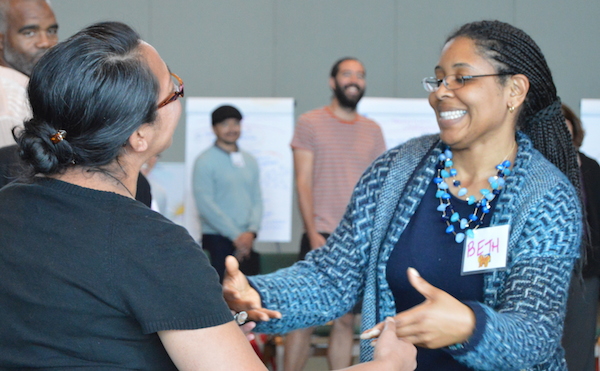How Liberation, Freedom, and Self Love Form the Foundation of Parenting in White Supremacy by Trina Greene Brown

Originally published on August 19, 2015.
I am raising a young Black boy in a society that is set up to set him up for failure.
This means I am often in protection mode: protection against educational inequity, unfair discipline practices, preschool-to-prison pipeline, stereotypical accolades, and most importantly, his own self-hate and internalized oppression (don’t get me started on my five year-old-telling me he wanted to “be White”).
This is the daily battle I try to prevent my son from dealing with, the daily battle where I try to be the buffer between him and the real world. I imagine myself as Super Mama, a powerful, badass mama with one hand holding a massive shield blocking my son, and the other, a powerful fist raised in resistance.
But in all of my fighting, resisting, and protecting, I now realize that I have been blocking my own heart: my hands have not been open to nourish and nurture my son. I see more clearly that I have been parenting from fear. I know that I must transition from parenting for protection to parenting for liberation.

My practice commitment is simple and affirmative: “saying yes.”
Yes to liberation.
Yes to freedom.
Yes to self love.
Underneath all of these affirmative statements is an internal struggle against a fearful and safe “no.”
After an amazing three days at Movement Strategy Center’s Transitions Lab in July, with brilliant leaders working across distinct but intersecting movements, I am metabolizing and distilling the lesson from the foundational question of our Lab exploration: “how do we transition from a world of domination and extraction to a world of interdependence, resilience, and regeneration?” As a movement maker and staffer of Move to End Violence, I am familiar with thinking about the “movement pivots” we need to make in order to go in a new direction. Now, as part of the MSC Transitions Lab, I am digging my heels deep into the “transitions” we want to make.
Transition is defined as “the process or period of change from one position or condition to another.” As a social justice movement leader, I have spent a lot of time focusing on the first part of this equation. Reflecting on my work in the violence against women movement, I know I expended a lot of energy naming the current period and existing conditions. This focus is present in the traditional names of our organizations. Much of our language and framing is issues-based (what we’re fighting against). We’ve become so skilled at naming the problem it’s become hard to name the solution.
The key word in the definition of transition is “another” — not just focusing on the issue but also transitioning in order to experience and create another circumstance or condition. My past work with young people was filled with opportunities to envision solutions. Young people (I know this sounds cliché) are the future and therefore have the capacity to vision a different world. A violence prevention curriculum I wrote with young girls was entitled “Be Strong” and spoke affirmatively from a strengths-based method for ending violence.
At the Transitions Lab, MSC guided us to think and vision a new world. We explored examples of movement strategies that employ visioning as a core element, such as my work with Move to End Violence, Octavia’s Brood, and Black Lives Matter. In each of these, social justice leaders are supported to think differently about their work.
I invite you, too, to spend time visioning, looking toward the horizon, and sharing ideas of the world you hope to create.
[Updated August 2015] Trina Greene Brown has worked in youth violence prevention as an educator, coordinator, advocate, and mentor for the past seven years empowering young people to build healthy relationships. Trina is a Movement Maker with Cohort 2 and currently serves as the Outreach and Engagement Manager for Move to End Violence.

